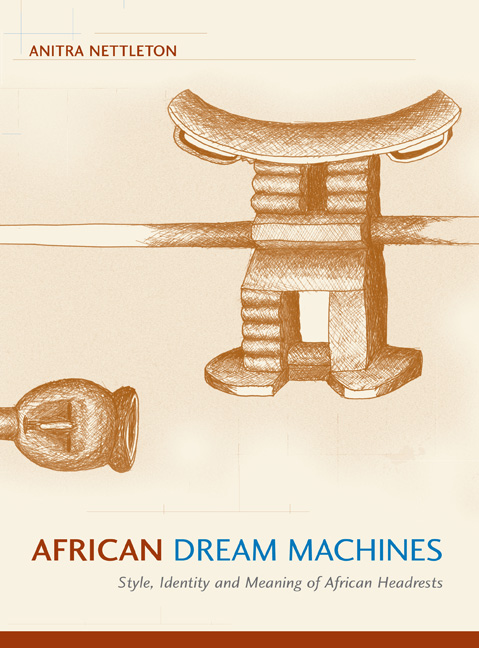Book contents
- Frontmatter
- Contents
- Preface
- Acknowledgements
- Notes on the Use of African Ethnic Names and Country and Place Names
- References to Illustrations in the Text and Notes on Illustrations
- Chapter 1 Headrests and Art
- Chapter 2 A Matter of Style, or, Why Style Matters
- Chapter 3 Methodology, Position and Limitations
- Chapter 4 The Geographical and Chronological Distribution of the Columned Headrest
- Chapter 5 Authenticity and History
- Chapter 6 East African Headrests: Identity, Form and Aesthetics
- Chapter 7 Tracing Histories: Central and Southern African Connections
- Chapter 8 Not Just a Curious Beauty: The Anatomy of Meaning in Useful Objects
- Notes to Chapters
- Bibliography
- List of Illustrations
- Index
Chapter 8 - Not Just a Curious Beauty: The Anatomy of Meaning in Useful Objects
Published online by Cambridge University Press: 18 May 2019
- Frontmatter
- Contents
- Preface
- Acknowledgements
- Notes on the Use of African Ethnic Names and Country and Place Names
- References to Illustrations in the Text and Notes on Illustrations
- Chapter 1 Headrests and Art
- Chapter 2 A Matter of Style, or, Why Style Matters
- Chapter 3 Methodology, Position and Limitations
- Chapter 4 The Geographical and Chronological Distribution of the Columned Headrest
- Chapter 5 Authenticity and History
- Chapter 6 East African Headrests: Identity, Form and Aesthetics
- Chapter 7 Tracing Histories: Central and Southern African Connections
- Chapter 8 Not Just a Curious Beauty: The Anatomy of Meaning in Useful Objects
- Notes to Chapters
- Bibliography
- List of Illustrations
- Index
Summary
FETISHISING HAIR
A PHOTOGRAPH OF Chief Twito Kilukwe (fig. 433) seated in a Western-style chair, dressed in ‘traditional’ finery, holding a staff in his right hand and a very small, but nevertheless probably functional, headrest in his left hand is an appropriate place to start an examination of discourses about function and meaning in relation to African headrests in particular, and the African or other material culture (including ‘art’) in general. The photographic portrait was ‘taken’ by William F. P. Burton, a missionary with the Preston Assemblies of God Church, at Mwanza, in Shaba (now Katanga) Province of what was then the Belgian Congo (now the Democratic Republic of the Congo or DRC) some time in the 1920s, as part of a project to record the customs of the local peoples. Burton's contribution was one among a number of others in which ethnic identities were created around the idea of a number of super-tribes, one of which was the Luba. Many of his photographs are part of what he saw as an effort to record the ways of life of the Luba (Becker 1991), some being formally posed and others apparently less so, allowing the possibility of reading them differently. That this image of Chief Kilukwe was staged in a particularly sympathetic way can therefore be seen as resulting from a negotiation in its construction between the sitter and the photographer. The chief 's Western-style chair, his elaborate shell and bead necklaces, beaded hairstyle and beaded tortoise-carapace vessel (balanced on his knee) are all objects that are documented as signs of status within Luba society of the time. But the headrest is not.While stools with female caryatid supports and staffs are fully documented as having been major status insignia within Luba history, there is no record of an equivalent status for headrests, even though they are recorded as having a place in important ritual contexts. Yet Chief Kilukwe had agreed to present himself, at missionary request, to the missionary camera with his beaded tortoise-shell container on his knee and his tiny headrest in his left hand balancing the staff in his right. The head of the sitter is framed by the bun hairstyle, by the white shells around his neck and by the upper reaches of the staff.
- Type
- Chapter
- Information
- African Dream MachinesStyle, Identity and Meaning of African Headrests, pp. 341 - 386Publisher: Wits University PressPrint publication year: 2007



